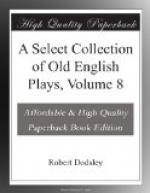Henry Chettle, who certainly joined Anthony Munday in writing “The Death of Robert Earl of Huntington,"[248] if he did not also assist in penning “The Downfall of Robert Earl of Huntington,” was a very prolific dramatic author. Malone erroneously states that he was the writer of, or was concerned in, thirty plays; according to information which he himself furnishes, forty-two are, either wholly or in part, to be assigned to Chettle. The titles of only twenty-five are inserted in the “Biographia Dramatica.” The proof of his connection with the historical play now reprinted has been already supplied,[249] and it is derived from the same source as nearly all the rest of the intelligence regarding his works—the MSS. of Henslowe.
Of the incidents of the life of Henry Chettle absolutely nothing is known: we are ignorant of the times and places of his birth and death, and of the manner in which he obtained his education. It has been conjectured that he either was, or had been, a printer, but the point is very doubtful.[250] In a tract by him, called “England’s Mourning Garment,” on the death of Queen Elizabeth, he speaks of himself as having been “young almost thirty years ago,” and as having been a witness of what passed at that period in the Court. If Ritson’s conjecture [had been] well-founded, he [might have been admitted as] an author as early as 1578;[251] but the poetical tract assigned to him [under that date was the work of some other writer with the same initials, whose name is not known.]
The first account we have of Chettle in connection with the stage is under date of April 1599,[252] when, according to Henslowe, he was engaged with Dekker in writing a play called “Troilus and Cressida;” but there is good reason to infer, that if in 1603 he were “young almost thirty years ago,” he had written for the theatre before 1599. Besides, in his “Kind Hartes Dreame,” produced about three months after the death of his friend Robert Greene, on September 3d, 1592, he speaks generally of his connection with the dramatic poets of that day, as if it were not newly formed. Malone supposed that Shakespeare, with whom Chettle had then recently become acquainted, was alluded to in the same tract. In “England’s Mourning Garment” Chettle addresses a stanza to “silver-tongued Melicert,” [whom some critics have supposed to be Shakespeare. But this is mere conjecture.]
Francis Meres, in his often-quoted “Palladis Tamia” (1598), includes Chettle in a long list of other writers for the stage, as “one of the best for comedy;” but in earlier works upon the poetry and literature of England, such as Webbe’s “Discourse” in 1586, and Puttenham’s “Art of English Poesie” in 1589, he is not mentioned.
Henslowe’s list of plays, with the authors’ names attached, as [edited by Mr Collier], begins [in February 1591-2;] and there the first mention of Chettle is in February 1597-8: between that date and March 1602-3, a period of little more than five years, he wrote, or assisted in writing, all the dramatic performances with which his name is associated; a fact of itself sufficient to show, if Henslowe be accurate, that in many of them his share must have been very inconsiderable, perhaps only amounting to a few alterations. They are the following, exclusive of those pieces already enumerated,[253] in which he was concerned with Munday:—




